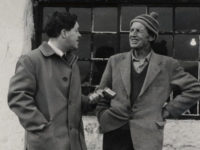Today, our homes usually reflect our circumstances and personal taste. When Orton and his fieldworkers were gathering data for the Survey of English Dialects, the design of most homes was closely linked to people’s occupations and social status. Their appearance and function reflected the basic requirements of life and work.
In the rural communities visited by the fieldworkers, transport was simple, functional and, more often than not, horse-drawn. Orton and his team captured the appearance and function of buildings and transport in rural England before modern life and inventions took hold. They took photographs and made illustrations and notes as a record of these traditional structures and modes of transport, paying particular attention to cottages, farmhouses, sheds, barns, and horse-drawn vehicles. They also recorded the dialect words used to describe them in each town and village.
Here we take a look at a snapshot of the material gathered by the fieldworkers, now preserved in the Leeds Archive of Vernacular Culture (LAVC). Together these items allow us to travel back in time and, for some, enjoy a trip down memory lane.


Have your say
Modern life is very different from that recorded by the fieldworkers in the 1950s and 60s. Farm machinery is now mechanised, building materials have changed, and you’re unlikely to see a horse-drawn cart on your commute to work! However, thanks to careful owners and communities, heritage organisations, and building regulations, many rural English villages have retained their traditional charm. Maybe you come from – or have holidayed in – a village or town with stone-built or thatched-roof properties. You can share your stories and add to this growing collection.
ContributeFind out more
Click on the links below to keep travelling back in time to rural England in the early to mid-1900s. You will know your cruck from your cuddy and your thatch from your fuzzock in no time.



